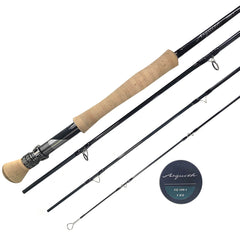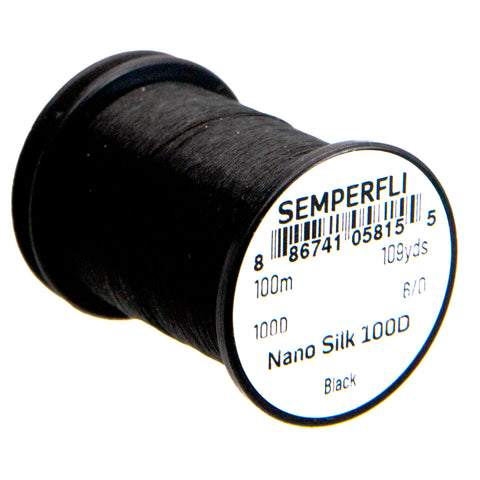The Asquith is thought by many to be the best fly rod ever made. Generally the only negative is the price. It was the first production rod to break the $1000USD mark back in 2017. With many rods now hovering around just under $2K the gap has narrowed, but the Asquith is still at the top.
It is not really until you cast this rod you realise how good it is – light, accurate and powerful with low swing weight they feel at home as soon as you pick one up.
The Asquith action is initially a little on the stiffer side, but from 30ft they come into their own and 40ft plus you are in another world. Mike recently fished the 4wt every day of August in Montana and believes there is no better rod, catching tiny brook trout, grayling and 24 inch rainbows on Henrys Fork. It loads perfectly with a Scientific Anglers MPX and for presentation a SA Trout Standard – which is what Mike was using. He has also fished the 9wt at Wessels Islands for big brawling saltwater fish. In fact his 9wt stayed with the guide as he had been chasing one for some time.
Mike recently spent all of August in Montana and caught up with Simon Gawesworth of RIO Fly Line fame at the Bob Jacklin casting pool at West Yellowstone one evening. Along with Justin Spence and Matt Klara (Big Sky Anglers) and Peter Hayes they turned a catch up into a casting competition – all casting the 4wt Asquith more than 110ft – that is a full flyline plus 20ft on a 4wt. Extraordinary stuff. It was an impressive display, but casting is not fishing, however it does prove its capabilities.
The Asquith series is the culmination of global cooperation in design, materials, and manufacturing techniques. The blanks are built in Japan at Kumamoto on Shimano’s proprietary Spiral X platform and assembled in USA, the Asquith boasts superb power transfer from tip to hand, quick recovery, and increased sensitivity. It is the only mass produced fly rod made in Japan – most are China, Korea or USA.
Designed by many time world casting champion Steve Rajeff, the Asquith is a step into the future of rod manufacturing technology. With fast actions, generous power levels, titanium guides, and exceptionally light swing weight, all rods in the series excel in fishing situations where developing high line speed and making precise casts means success.
Essential Flyfisher has all weight Asquiths in stock 4wt to 12wt.
See what Steve Rajeff has to say about the Asquith
There is no one, nor will there probably ever be, another Steve Rajeff. Steve has won more Casting Titles than anyone.
Steve Rajeff Bio
American Casting Association Press Release: 7 September 2017
Steve Rajeff was born in San Francisco in 1956. Steve grew up a few blocks away from the Golden Gate Angling and Casting Club. Mel Kreiger’s daughter introduced Steve to Mel when he was age 9 or 10 and Mel saw promise in the boy’s casting. Within weeks of beginning instruction with Mel, Steve beat Mel and all the men at GGACC in the ACA events they cast! The young Steve was given a private locker to store his tournament rods at the ready. Riding his bike there, he cast 300 days a year. The other days he fished in the mountains with his family. He was also interested in fly tying and owned a copy of Art Flick’s- New Streamside Guide. The student became the teacher.
Around 1970, Steve taught with Mel at the Fenwick Fly Fishing School in California, organized by Jim Green of Fenwick. Jim is known for his casting and teaching but also for innovations like the first tip over butt ferrule, the patented Ferrulite.
Trying to improve equipment and working with Jim Green got him interested in rod manufacturing. Jim taught Steve how to design glass tournament blanks and shared the introduction of graphite and boron with Steve, who was one of the first to test them and show them to the public.
The casting of National and International casting champion, Jon Tarantino inspired Steve to compete and use him as a role model. At age 13 GGACC sponsored Steve to travel and compete in the 1971 ACA Nationals in St. Louis. Steve took third in the All-Around. Two years later, at 15, he took first!
After attending Lowell High School, he enrolled at San Francisco State and focused on Math and Science and earned a Business Degree in Marketing. His sights were still on the fly fishing industry.
During summers when school was out, he guided at Kulik Lodge, Alaska and was one of the first guides, or anglers, to explore Bristol Bay. He taught at the Fenwick Fly Fishing Schools in Idaho and Montana in the ‘70s with Ernie Schwiebert, Mike Lawson, Will Godfrey, Bud Lilly, Bob Jacklin, Rene Harrop and others. He was one of Sandy Moret’s original instructors at the Florida Keys Outfitters Fly-Fishing School, founded in 1989. He is among faculty greats such as Chico Fernandez, Jerry Siem, Steve Huff and others.
Steve Rajeff’s first industry job was at Winslow Manufacturing, started by Don Green; ex-director of Public Relations at Fenwick Fly Rod. Don was head of product development of the Winslow Rod. The company had to change its name two years after formation because of a conflict and Steve helped select the name Sage from their choices.
At age 22, Steve’s first project at Sage was to drive all over the Rockies and West to open their first dealer network of 110 stores. Steve served for a short while as Sage’s manufacturer’s sales representative and tackle developer but wanted to have an equity stake for the future.
Then fortuitously, he met the inventive Gary Loomis who had started his namesake company, G.Loomis. Steve saw a future with Gary and came on board. Gary shared his rod-building skills with his new designer. Steve took over design and is responsible for the actions of the first IMX and GLX rods. These were evolutionary rods using different levels of graphite modulus.
Steve Rajeff is responsible for designing the first single-foot fly-rod guides and bringing fly rods to the market with them. He came up with the idea during development of G.Loomis GLX fly rods in 1994.
He prototyped the single foot by taking a normal snake and bending it around into the single foot shape. Steve achieved an overall weight reduction of the thread and mainly, the epoxy finish, on up to 8 guide locations of a typical 9-foot fly rod. It was like removing two to three guides from the rod.
The result was a guide that cast indistinguishably from a normal snake of the same diameter and the line shot through without a hang-up. When a knot in the leader or a small knot in the line occurs, and tries to pass through the guides, single feet will help it pass without damage or break-off. With double foot guides, the knot will often catch at the base of the guide-foot.
This decreased swing weight, increased flexibility and lack of interference noticeably helped improve rod recovery, crispness and smoothness of the line flow.
His brother Tim, also working at G.Loomis then, was equally impressed. At the time, a large portion of their guides were being supplied by Pacific Bay company, and the team worked together to have them mass produced. Partially because of this introduction, the GLX series was a big hit. Single-foot guides are used by many fly-rod manufacturers today.
Gary sold the company to Shimano International in 1997 because of health reasons but was retained as a consultant for a number of years. Since then, Steve created the NRX line of rods incorporating the new Nano-resin technology from 3M for the first time on any rod. G.Loomis had a limited time exclusive on the technology.
Recently he designed the actions for the revolutionary Asquith line of rods using the propriety Spiral-X process, which is spine-less. This promises to be a breakthrough because they track straighter. They were released in the summer 2016.
Steve designed all the rods the G.Loomis company offered over a span of the last 30 years, from 1985. Today, the Woodland, Washington company turns out 500 rods a day! Steve has prepared his employees for the future by teaching them the art and science of rod design. He has helped create and define the corporate values for training, opportunity and environmental responsibility.
Steve has been giving free casting lessons, tips and demonstrations to the public for forty years without self-agrandisment. As a teen he gave demonstrations on the roof of the Abercrombie & Fitch store in NYC on Madison Avenue. You can see him at fly-fishing shows today around the country modestly showing how to improve casting (while inspiring and preserving the dignity of his students.) He helps and welcomes newcomers at casting tournaments and volunteers to give free demonstrations at clubs.
He is an amazing rod designer, caster, angler, accomplished fly tier and advocate of conservation. Steve is currently serving as Vice-President of the American Casting Association, a 501(C)3 organization.
Steve’s tournament Casting accomplishments to date include 45-time Grand All Around Champion of the American Casting Association. He is also 14-time World Casting Champion, eclipsing Jon Tarantino’s 6 World Championships. In competition in ICSF 2-Hand Fly Distance in Toronto he cast 306 feet. In 2009 at the World Championships of Fly Casting in Ireland, Steve cast 165 feet with a floating line and 36 feet of backing. In the Sea Trout Event, the official line is an 8wt WF floating line measuring 120 ft.
Steve has been an integral part of the modern fly fishing age. For the future, he looks forward to new technology, good fishing and matching the casting longevity of one of his mentors, the late Dick Fujita, who participated in 52 ACA Nationals.
On October 7th 2017 he was inducted into the Catskill Fly Fishing and Museum Hall of Fame.
We carry most Asquith tips in stock. $200
Most current rod tips can be ordered and can take 4 to 12 weeks depending on production.






















